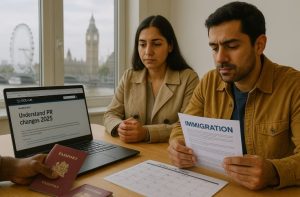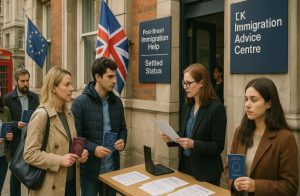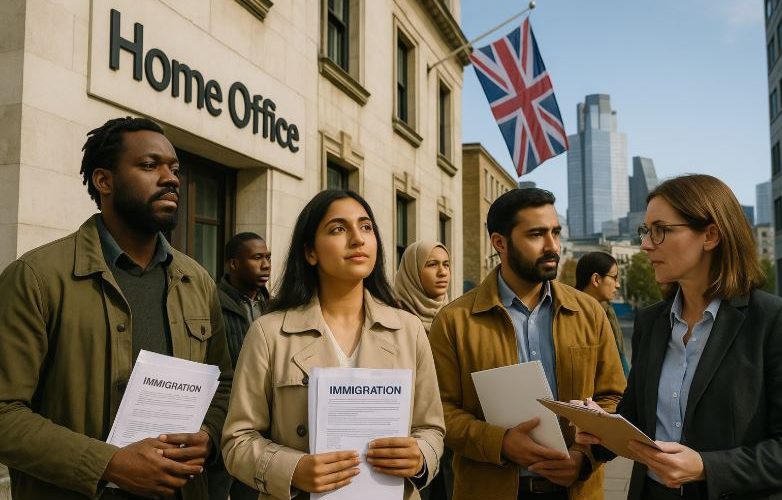For many immigrants living in the United Kingdom, permanent residency is more than just a legal status. It represents stability, the ability to plan long-term, and a sense of belonging. With the new PR rules in UK 2025, this journey toward settlement has taken a new direction.
As someone watching these shifts from the perspective of those affected, it’s clear that changes brought by the UK Home Office are not just bureaucratic updates. They are deeply personal for the thousands striving to make the UK their permanent home.
In April 2025, sweeping reforms were rolled out, targeting a range of immigration categories from skilled workers to family routes.
The latest updates have not only changed eligibility criteria for permanent residency (also known as Indefinite Leave to Remain or ILR), but they also reflect the UK’s evolving immigration philosophy. This blog explores the revised rules in detail, helping immigrants navigate the updated process with clarity and confidence.
What Is PR Rule in UK and Why Is It Changing in 2025?

Permanent Residency (PR) in the UK, also known as Indefinite Leave to Remain, grants an individual the right to live and work in the country without time restrictions.
Historically, applicants could apply after residing in the UK lawfully for five continuous years under specific visa categories. However, in 2025, the PR rules have been revised substantially.
Why the Changes Now?
The UK government’s decision is part of a broader effort to tighten immigration, reduce net migration figures, and ensure that long-term settlement is granted only to those who meet updated criteria.
The new changes align with the UK’s post-Brexit stance, reflecting the nation’s emphasis on a points-based system and self-sufficiency of immigrants.
Key Shifts Behind the Reforms
- A redefinition of what counts as “lawful residence”
- Tighter requirements for dependants and family members
- Adjustments in salary thresholds for work visa holders
- A new focus on continuous and economic contribution to the UK society
These changes are not just about numbers. They aim to reinforce the message that while the UK welcomes skilled immigrants, it expects strong integration and compliance with evolving standards.
How Has the Home Office Updated the Definition of “Lawful Residence”?
One of the most significant and complex updates in the new PR rules in UK 2025 is the redefinition of “lawful residence”.
The Previous Understanding
In earlier immigration policies, time spent under any lawful visa, including time under visitor visas or certain short-term study visas, was often counted towards residency. This allowed some flexibility for applicants who had mixed visa histories.
The 2025 Revision
From April 2025, the Home Office clarified that only residence under routes that lead to settlement will now be considered for ILR. Time spent under non-settlement routes, such as visit visas or certain short-term student routes, is no longer valid when calculating the qualifying period.
Key Highlights
- Time spent under the Graduate Visa is now excluded from counting towards ILR.
- Applicants under temporary routes must now switch into a qualifying route and reset their settlement clock.
- The definition also introduces stricter checks on immigration compliance history, including absences and breaches.
This change has impacted many who previously relied on combining different visa types to build their five-year lawful residence. The shift demands more planning and strategy for immigrants who aim to settle in the UK.
What Are the Changes in ILR (Indefinite Leave to Remain) Requirements?

The ILR pathway is now more streamlined but also more demanding. The New PR Rules in the UK 2025 bring several critical updates that applicants must be aware of.
Skilled Worker Route
The most notable changes affect skilled workers who are now subject to higher salary thresholds. Applicants must now demonstrate a minimum salary aligned with the 2025 revised thresholds, adjusted to current UK earnings levels.
Family Routes
Dependants must meet stricter financial requirements and may now need to pass English language assessments at higher levels.
Long Residence Route
The long residence pathway still exists, but with tighter conditions. Applicants must show continuous residence without significant absences and full compliance with visa conditions.
Minimum Salary Requirement
- As of April 2025, the general salary threshold has increased significantly, impacting skilled workers and Tier 2 visa holders.
- The updated threshold aligns with the UK’s economic climate and minimum wage growth.
These ILR changes are intended to reward immigrants who make consistent and economically valuable contributions to the UK over time.
What Are the New PR Rules in UK 2025?
The Skilled Worker route remains the most common pathway for PR applicants, but the 2025 reforms have introduced more hurdles.
Salary Threshold Adjustments
Workers must now earn at least £38,700, up from the previous threshold of around £26,200. This is a major leap, meaning many lower-paid roles, even within skill-shortage sectors, may not qualify for settlement.
Sector-Based Exceptions
Some exceptions exist for roles in health and social care, but even these require updated job codes and documentation to ensure eligibility.
Sponsorship and Continuity
A skilled worker must remain sponsored by a licensed employer throughout the qualifying period. Any breaks in employment, particularly if longer than 60 days, could reset the PR clock.
Important Points to Note
- Employers must confirm their sponsorship continues until the application is processed
- Applicants must show financial stability without recourse to public funds
These changes signify the government’s push to prioritise long-term, skilled, and stable employment in the UK.
How Do the 2025 Immigration Reforms Affect Family and Dependant Routes?

Family routes to PR have always been complex, but the 2025 reforms added another layer of scrutiny.
Dependants Face Tighter Conditions
- Language and Integration: Dependant spouses and adult children must now pass an English language test at B1 level or higher, as opposed to the previous A1 requirement.
- Financial Independence: Families must now meet a combined income threshold of at least £29,000, with expectations rising further by 2026.
- Relationship Validity: The Home Office has intensified its scrutiny of marital and civil partnerships, demanding more documented evidence of genuine relationships.
Children Born in the UK
- Children born to parents on temporary visas still need their parents to secure ILR before gaining automatic rights.
- Even those with a school history in the UK may face limitations unless their parents meet the settlement criteria.
These changes represent a clear move toward tighter family reunification policies and higher integration benchmarks.
What Is the Role of the Statement of Changes in Immigration Rules?
The Statement of Changes is an official document released by the UK government that details amendments to immigration law. It plays a pivotal role in the New PR Rules in UK 2025. The statement outlines specific legal text updates, allowing stakeholders, including lawyers and applicants, to understand shifts in immigration law.
- The April 2025 Statement of Changes (HC 590) redefined lawful residence
- Updates to Appendix Continuous Residence introduced stricter conditions
- Detailed amendments were made to Appendix Settlement Family Life and Appendix Skilled Worker
Every major PR rule change in 2025 is legally grounded in these statements. They provide the authoritative language and framework for immigration professionals and individuals navigating the system.
Keeping track of these documents is crucial for any applicant serious about planning their long-term UK residency.
Who Is Most Affected by the Changes to the British Citizenship Pathway?
The changes introduced in 2025 have also extended their impact beyond PR to British citizenship eligibility.
Direct implications
- A longer PR period may be required before naturalisation
- Stricter checks on absences and visa compliance history
- Higher English language and Life in the UK Test requirements
Affected demographics
- Young professionals using Graduate or Start-Up visas
- Migrants from non-settlement routes
- Families transitioning between different visa types
These updates signal the government’s intent to link citizenship with economic contribution, long-term residence, and active participation in British life.
What Do These Changes Mean for EU and EEA Nationals Post-Brexit?

While most of the initial Brexit-related immigration adjustments have been completed, EU and EEA nationals still face ripple effects from the New PR Rules in the UK in 2025.
Settled status complications
- Some individuals who missed the EU Settlement Scheme deadlines must now follow standard PR rules
- Lawful residence is no longer backdated to early stays unless under recognised schemes
Shifting to Skilled Worker or Family Visa
EU citizens now require the same sponsorship and income requirements as others, eroding their previous advantages.
This change reflects the UK’s full departure from the EU’s free movement framework, placing all migrants on an equal, rule-based footing.
How Can Immigrants Prepare for UK PR Under the 2025 Immigration Policies?
With so many updates, strategic preparation is more essential than ever for immigrants planning to apply for PR.
Understand your visa route: Review if your current visa leads to settlement and what new criteria apply.
Track residence and absences
- Maintain detailed records of your travel history
- Avoid long periods outside the UK, which can reset your settlement clock
Meet financial and language criteria
- Plan income progression and savings
- Enrol in English language and Life in the UK test courses early
Seek legal advice: Immigration policies are complex. Professional advice can prevent costly mistakes.
Conclusion
The New PR Rules in UK 2025 signal a new era in British immigration. The updates reflect not just a legal change, but a broader shift in how the UK views long-term immigration, integration, and residency.
For those already on the path to settlement or beginning their journey, understanding the reforms is crucial. Whether you’re a skilled worker, family member, or someone pursuing citizenship, preparation and awareness will make the difference.
These rules may feel restrictive, but with proper planning and understanding, the dream of making the UK your permanent home is still very much within reach.
Frequently Asked Questions
How has the concept of lawful residence changed in the 2025 UK PR rules?
Lawful residence now only includes time spent under visa categories that directly lead to settlement, excluding short-term or visitor visas.
What salary do skilled workers need to earn in 2025 to qualify for PR?
They must now meet a minimum salary threshold of £38,700 unless they fall under specific exceptions like health and care roles.
Can time on a Graduate Visa count towards PR in the UK?
No, time spent under the Graduate Visa no longer counts towards Indefinite Leave to Remain under the 2025 rules.
Do family dependants face new PR eligibility criteria?
Yes, dependants now need to meet higher financial thresholds and may need to pass an English language test at B1 level or above.
What role does the Statement of Changes play in immigration policy?
It outlines all official amendments to immigration laws, making it a key reference for understanding any updates to PR eligibility.
Are EU citizens still eligible for settled status in 2025?
Only those already under the EU Settlement Scheme. Others must now follow standard immigration and PR rules.
What should applicants do to prepare for PR under the 2025 rules?
They should track their visa history, meet financial and language criteria, and consider consulting an immigration expert.









